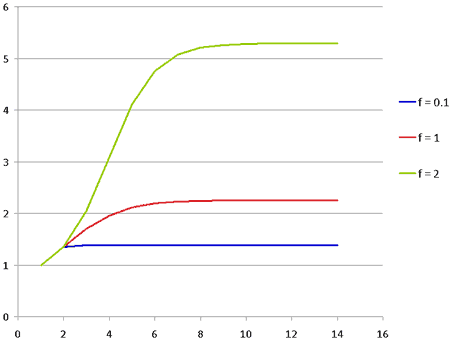Does positive feedback necessarily mean runaway warming?
What the science says...
| Select a level... |
 Basic
Basic
|
 Intermediate
Intermediate
|
 Advanced
Advanced
| ||||
| Positive feedback won't lead to runaway warming; diminishing returns on feedback cycles limit the amplification. | |||||||
Climate Myth...
Positive feedback means runaway warming
"One of the oft-cited predictions of potential warming is that a doubling of atmospheric carbon dioxide levels from pre-industrial levels — from 280 to 560 parts per million — would alone cause average global temperature to increase by about 1.2 °C. Recognizing the ho-hum nature of such a temperature change, the alarmist camp moved on to hypothesize that even this slight warming will cause irreversible changes in the atmosphere that, in turn, will cause more warming. These alleged "positive feedback" cycles supposedly will build upon each other to cause runaway global warming, according to the alarmists." (Junk Science)
Some skeptics ask, "If global warming has a positive feedback effect, then why don't we have runaway warming? The Earth has had high CO2 levels before: Why didn't it turn into an oven at that time?"
Positive feedback happens when the response to some change amplifies that change. For example: The Earth heats up, and some of the sea ice near the poles melts. Now bare water is exposed to the sun's rays, and absorbs more light than did the previous ice cover; so the planet heats up a little more.
Another mechanism for positive feedback: Atmospheric CO2 increases (due to burning of fossil fuels), so the enhanced greenhouse effect heats up the planet. The heating "bakes out" CO2 from the oceans and arctic tundras, so more CO2 is released.
In both of these cases, the "effect" reinforces the "cause", which will increase the "effect", which will reinforce the "cause"... So won't this spin out of control? The answer is, No, it will not, because each subsequent stage of reinforcement & increase will be weaker and weaker. The feedback cycles will go on and on, but there will be a diminishing of returns, so that after just a few cycles, it won't matter anymore.
The plot below shows how the temperature increases, when started off by an initial dollop of CO2, followed by many cycles of feedback. We've plotted this with three values of the strength of the feedback, and you can see that in each case, the temperature levels off after several rounds.

So the climatologists are not crazy to say that the positive feedback in the global-warming dynamic can lead to a factor of 3 in the final increase of temperature: That can be true, even though this feedback wasn't able to cook the Earth during previous periods of high CO2.
Note: A more detailed explanation is provided here.
Last updated on 13 September 2010 by nealjking.































 Arguments
Arguments































[DB] Since you are fond of analogies, let me share this one with you:
Your conundrum, distilled, is that you are treating climate science as some that learn a foreign language: you are insisting upon translating the words you hear into English before assembling them into sentences. However, to truly learn a foreign language, one must learn enough vocabulary, sentence structure and syntax to understand the foreign language in your head without the need for translation. In essence, you need to be able to think in that foreign language before true understanding of it is then reached.
That is what is retarding your understanding. As it has retarded the understanding of electrical engineer-types like RW1 and co2isnotevil before you.